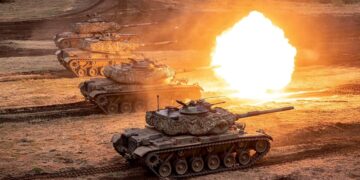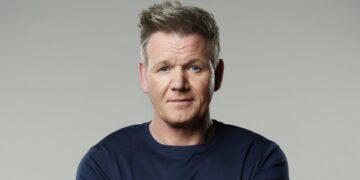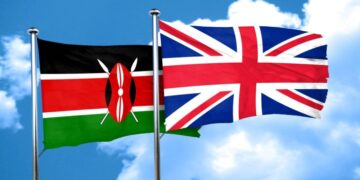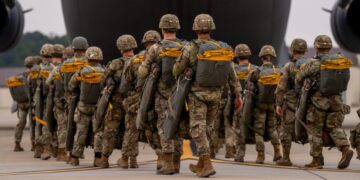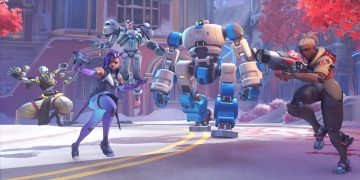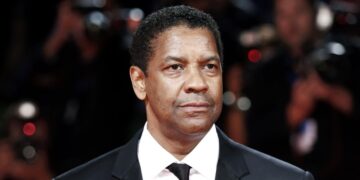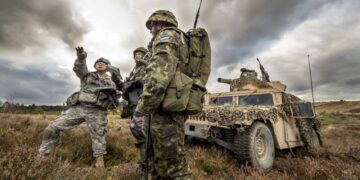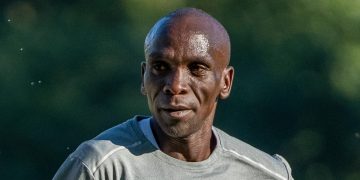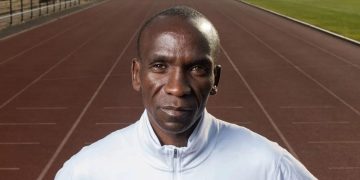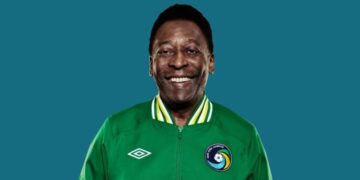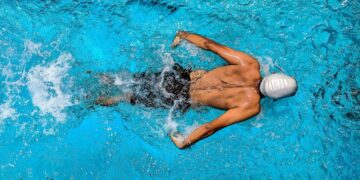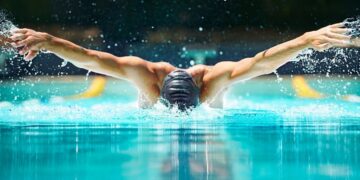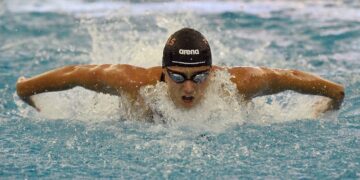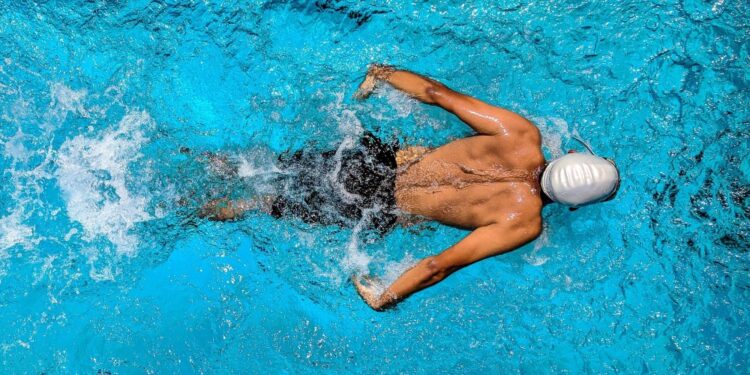Swimming is a solo sport where the participant must move their complete body inside (through) water. Doesn’t it appear to be simple? In actuality, overcoming the drag that water causes owing to its viscosity takes a lot of work. While you may feel lighter in the water, the drag will never allow your muscles to rest while moving. This allows muscles to be exercised without placing stress on bone joints.
Whether you want to learn how to swim for competition, exercise, or safety, it’s best to learn several different swimming styles and strokes as each offer different advantages in different situations. For competition, the versatility will allow swimmers to compete in multiple events. For exercise, different muscles are used for different strokes, so learning all of the strokes provides a more comprehensive workout. For safety, different strokes can be used depending on the dangers of a particular situation.
Here are the different types of swimming styles and strokes.
1. Front crawl (Freestyle)
Front crawl, also known as freestyle swimming, is the fastest and most efficient kind of swimming in which a person swims with his body straight and travels forward in the water. Furthermore, it is the most popular form of swimming since every beginner begins with freestyle and progresses to other methods. There are generally few regulations in effect during freestyle competitions.
Distances in freestyle races often range from 50 metres to 1,500 metres. Regarding the advantages, swimming experts advocate starting with freestyle since it provides full exercise for the body and allows a person to cover a longer distance with less energy expended by employing front crawl strokes. Here’s how to do front crawl swimming strokes:
Body movement
- The body is in a horizontal position, face down in the water, during freestyle.
- The head is constantly in a neutral position and only rotates to breathe on either side.
- To swim ahead in the water, the body rolls from side to side.
Arms movement
- One arm extends first while the other recovers underwater.
- Down-sweep is performed by lowering the forearm and raising the elbow. The upper arm is used to move forth and backwards.
- One arm pulls the water during In-sweep. Up-sweep follows, with another arm pushing against the water.
- The forearm relaxes when the arms swing forward during recovery.
Legs movement
- A flutter kick is used in freestyle. It refers to feet that are spread out and move quickly.
- The flutter kick alternates between two directions. In a steady action, one leg rises while the other descends.
2. Backstroke
Backstroke, also known as back crawl, is the polar opposite of front crawl (freestyle). Harry Hebner popularised the backstroke. In the 1990 Olympics in St. Louis, backstroke was recognised as a competitive swimming event. The difficulty of breathing while front crawl swimming was one of the key reasons for its discovery. As a result, backstroke became its polar opposite, so it’s also known as back crawl. According to experts, backstroke helps to improve body posture. Here’s how to perform backstroke swimming strokes:
Body movement
- The corpse has been rotated backwards and is floating horizontally.
- Following arm motions, the body rolls from one side to the other.
- While the face is up, the head stays neutral.
Arms movement
- Water is pushed backwards with outstretched arms.
- The movement is in the shape of an S.
- Arms travel from one hip to the other during recuperation.
- During rehabilitation, the arms are straight.
Legs movement
- Flutter kick is a swimming technique that is utilized when swimming backstroke.
- Alternative up-down kicks in vertical directions with pointed feet.
3. Breast stroke
It may come as a shock to you, but what I’m going to tell you is real. Among all the different types of swimming kicks and styles, breaststroke is the most popular. A swimmer’s body faces down into the water while his head is up. As a result, breathing is simple. Out of all the swimming strokes, many beginners and casual swimmers prefer breaststroke.
Breaststroke is the slowest swimming stroke, according to another fascinating statistic. So, if you’re seeking a fun way to swim, opt for breaststroke. According to fitness experts, breaststroke is a cardiovascular workout that strengthens the heart and promotes blood circulation. Here’s how to perform breaststroke swimming strokes:
Body movement
- During breaststroke swimming, your body posture changes constantly. When a person begins to swim, it shifts from horizontal to inclined.
- The torso assumes a 45-degree angle above the water as the body travels forward in the water.
- Throughout the swimming action, the head is aligned with the body.
Arms movement
- The arms are stretched forward at first.
- Arms move outwards with the first pull, then backwards, and finally downwards.
- Elbows stretch to the level of the shoulder blades.
- Hands move towards each other under the chest as the arms travel rearward.
Legs movement
- Frog kick or whip kick is used in breaststroke.
- Legs are stretched during the arm pull phase.
- The knees bend and go towards the hips after that.
- During breaststroke swimming, the feet travel forth and backwards.
4. Butterfly stroke
The butterfly stroke is the newest of all types of swimming kicks and styles. It began as a spin-off of breaststroke in 1933. Sydney Cavil, an Australian swimmer, is credited with popularizing this stroke. Due to both arms and legs’ simultaneous pull/push, the butterfly stroke is quicker at the peak stage than Freestyle.
During the recovery period, however, the stroke slows down. As a result, the butterfly stroke becomes a slower overall swimming technique. The toughest stroke in swimming, according to experts, is also the finest for improved body conditioning and muscular strengthening. Here’s how to perform butterfly swimming strokes:
Body movement
- As swimming begins, the body begins to float horizontally on the chest.
- The head is always in line with the torso with the face down in the water.
- Wave-like motions occur when the body picks up speed.
Arms movement
- Arms enter one after the other as the body heals.
- Arms extend straight for a brief period due to the drooping chest.
- When the palms and forearms are in a line pointing backwards, it’s called a catch.
- Then there is a constant in-sweep and out-sweep.
- Finally, release and recuperation assist the body in resting.
Legs movement
- The dolphin kick is used in the butterfly swimming stroke.
- A person begins a whipping action of their legs with pointed feet.
- Legs move in lockstep with the hips as they rise.
- The cycle continues, with legs following the hips as they are straightened, legs doing the whipping movement, and so on.
5. Sidestroke
The sidestroke method is accomplished when the swimmer’s body leans on one side while motioning with asymmetric arm and leg motions. It is typically utilized for long-distance swimming. Swimmers have been observed utilizing this method to relax after a long hour of swimming. Even better, the sidestroke is employed as a life-saving technique with caution.
Swimming experts promote the sidestroke technique, believing that mastering it can propel young swimmers to new heights in the sport, as it gives much-needed flexibility. Until recently, it was usually considered that breast or belly swimming was the fastest technique; however, this notion has proven false. The sidestroke is now widely recognized as the superior technique, and young swimmers would be well to practice it properly. Here’s how to do sidestroke swimming techniques:
Body movement
- The swimmer begins by reclining on one side with their legs spread out.
- The upper arm is flat on the body’s side.
- Half of the face is submerged, and the head is aligned with the spine.
Arms movement
- The lower arm is thrust back against the water, bent at the elbow.
- An insweep is performed with the palm facing upwards and the hand reaching in front of the chest.
- The upper arm pushes against the water while the lower arm stretches back to the front.
Legs movement
- A scissors kick is used in sidestroke.
- The upper leg is bent, and the knee and the foot are brought to the chest.
- The lower leg then bends, and the foot slides towards the back of the body.
- It is critical to have flexible coordination between the arms and legs.
6. Trudgen
Trudgen is a swimming style named after English swimmer John Trudgen. It is also known as the racing stroke. This stroke is a variant of the sidestroke. This unique method helped John become the quickest sprinter of his day. Keeping flat on his chest with his head carried high in the air, John startled onlookers by swinging each arm alternately over the water and making one horizontal breast-stroke kick to each cycle of the arms so that his body lifted and progressed in jerky leaps. Here’s how to do trudgen swimming strokes:
Body movement
- From the stomach to the side, the body moves.
- It should be located beneath the water’s surface.
- Only the arm stroke and breathing cause the body to rise.
Arms movement
- Arm limbs should just emerge from the water.
- Elbows are angled toward the ground.
- Arms are spread out in front of you, palms facing down.
- To go ahead, the arms alternately loop water to the back.
Legs movement
- Legs alternate between scissors and dolphin kicks.
- On a horizontal plane, the feet are together.
- Legs are raised up to the top of the torso.
- When the hands travel to the front, it’s called a scissor kick.
- When the arm strokes resume, the feet come together in a dolphin kick.
7. Combat sidestroke
CSS (combat sidestroke) is a variation of the standard sidestroke. The US Navy SEALs were the first to use it. Former Navy SEAL Stew Smith (CSCS) and Terry Laughlin of Total Immersion Swimming, in particular, were instrumental in the invention of this sidestroke. According to experts, it’s also very efficient and calming, and it’s a combination of sidestroke, front crawl, and breaststroke. To carry heavy equipment underwater, US Navy SEALs train the combat sidestroke technique. Here’s how to perform combat sidestroke swimming techniques:
Body movement
- Underwater, the body should be flat.
- The body shifts to either side for breathing while floating.
- The body should be as near to the surface as possible.
Arms movement
- Throughout the stroke, all arm movement takes place underwater.
- In a streamlined position, the arms spread out together over the head.
- Shoulders are lowered to aid in body rotation from one side to the other.
Legs movement
- During fighting sidestroke, the legs perform the greatest work.
- Its major goal is to propel the body ahead quickly.
- A scissors kick initiates leg movement.
- The leg closest to the ground pulls the body forward, while the bottom leg extends the body back.
8. Snorkeling
Snorkeling is a type of swimming when a person is fully-clothed. It is more of a leisure sport. A diving mask is required, including a tube (snorkel) and frequently paired with a set of fins. The mask enables clear eyesight underwater, the snorkel aids in breathing when submerged in water, and the swim fins allow for easier movement.
Snorkeling does not need any specific training or much physical exertion. Many people compare it to scuba diving; however, scuba is deeper than snorkeling, which requires a person to float near the surface. Snorkeling is primarily done around barrier reefs, islands, and cays. Here’s how to perform snorkeling swimming strokes:
Body movement
- In a horizontal position, the body must be straight.
- Swimming should be done with the head down in the water.
- Because breathing is done through the snorkel, the body does not turn to either side.
Arms movement
- It begins with one arm reaching underwater as the other recovers.
- Down-sweep is performed by lowering the forearm and raising the elbow.
- The upper arm is used to move forth and backwards.
- One arm pulls the water during In-sweep. Up-sweep follows, with another arm pushing against the water.
- The forearm relaxes when the arms swing forward during recovery.
Legs movement
- A flutter kick is employed, same as in freestyle. It refers to feet that are spread out and move quickly.
- The flutter kick alternates between two directions.
- In a steady action, one leg rises while the other descends.
9. Fins swimming
Fins swimming comprises swimming with fins either on the water’s surface using a snorkel with either monofins or biffins or below with monofins either by holding one’s breath or with open-circuit scuba diving equipment. Here’s how to do fins swimming techniques:
Body movement
- A streamlined physique is required for this method.
- The head should be pointing downwards.
- To maintain appropriate breathing, the body must move from side to side.
Arms movement
- Arms work the same way they do in freestyle.
- It begins with one arm reaching underwater as the other recovers.
- Down-sweep is performed by lowering the forearm and raising the elbow.
- The upper arm is used to move forth and backwards.
- One arm pulls the water during In-sweep. Up-sweep follows, with another arm pushing against the water.
Legs movement
- Leg training is the most important aspect of fins swimming.
- To propel the body forward, tight-fit fins are alternatively flapped in the water.
- Leg work that is consistent and fluid aids the fins in their task.
10. Corkscrew swimming
It’s essentially a drill in which a swimmer practices underwater. It gives the body more flexibility, making other types of swimming exercises much easier to master. Corkscrew is a freestyle and backstroke hybrid. It continues with three freestyle strokes, followed by three backstroke strokes. Here’s how to perform corkscrew swimming strokes:
Body movement
- Given the combination of two opposing styles, the body moves a lot from side to side.
- Swimming can be done on either the back or the stomach.
- According to the shifting fashions, the head posture changes.
Arms movement
- If the body starts to float on its stomach, the arms stretch out first.
- The body shifts to its back after three front arm strokes.
- The arms then follow the backstroke arm action three times in a row.
Legs movement
- Flutter kick is used frequently in corkscrew swimming.
- Continuous flutter kicking helps to maintain proper equilibrium.
Conclusion
As with any sport, the best way to improve or to become truly great is with hard work and practice. Taking swimming lessons is a great place to start, regardless of age or skill level. And most importantly, spend as much time as you can in the water. There are five skills that are important for every swimmer to know:
- Breathing technique.
- Gliding with your face in the water.
- How to coordinate various body parts during movement.
- Stroke styles/swimming techniques.
- Diving.


